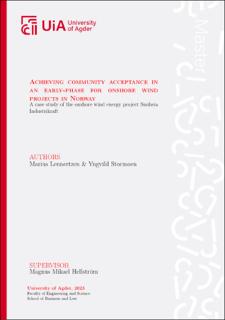| dc.description.abstract | Renewable energy is crucial for sustainable energy production to combat climate change. One global pillar in renewable energy production is wind power. However, it is not always easy to get acceptance within local communities and social license to operate when discussing wind power development. This issue is especially present in a country like Norway, with a lot of scenic beauty to offer. By looking at a case from Høyanger and Sunnfjord municipality, this thesis aims to create a model to follow for gaining higher community acceptance and social license to operate amongst local communities in early-phase wind power development projects in Norway.
Hydro and Eviny released a press statement on December 19th, 2022, expressing their intentions of pursuing the development of a wind power plant in the mountain area called Snøheia, on the border between Høyanger and Sunnfjord municipality in the western part of Norway. The project is dependent on local acceptance and political approval. Therefore, Hydro and Eviny want to start a dialogue with the local community and the municipal council which distinguishes this project from other similar projects. The early dialogue, in what can be described as "phase-zero", is an unusual approach. It is a new way to communicate the project at this early stage, and hence, there exists no best practice to follow to create the acceptance needed to get the green light for the project.
To identify concerns and expectations for the project and how to create higher community acceptance of wind power development, a mixed approach with the combination of interviews and surveys has been used. To get a perception of the public opinion, a survey was issued. The survey has been used to compare the answers from the informants during the interview with the answers from the local community.
The results indicate both sides struggling to engage the silent majority and increase the acceptance of the project within the local community. To overcome these issues, a model based on stakeholder engagement and social acceptance has been developed. The model consists of four steps: Motivate, Interactive, Inclusive, and Change. Each step is described with corresponding actions and purposes as a guide to implementing the model. Through an iterative process of repeating these steps, higher community acceptance for onshore wind power development in Norway can be achieved. | |
